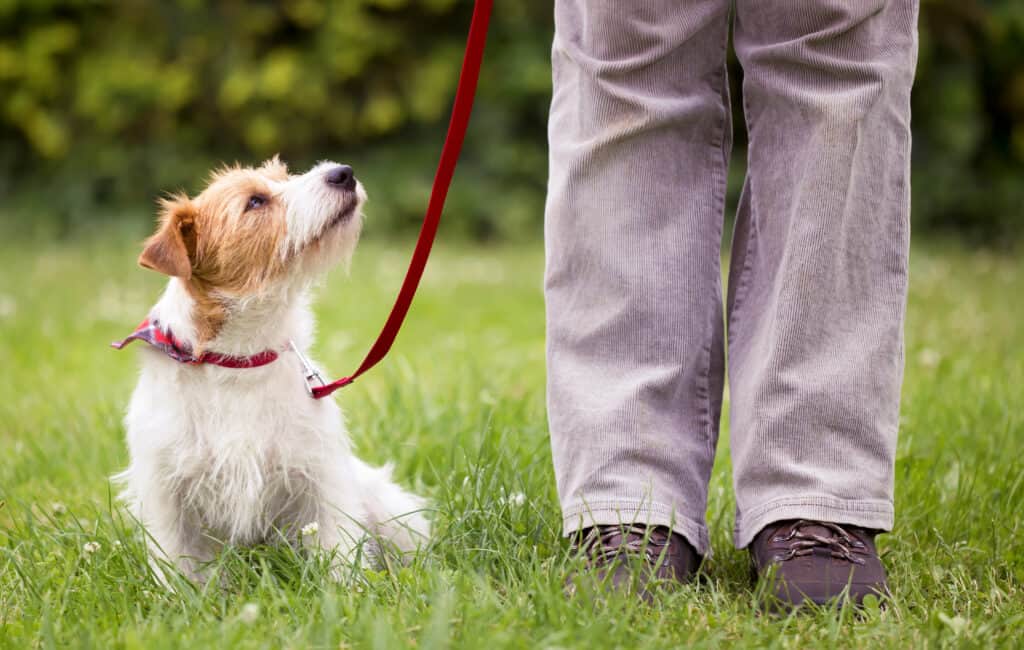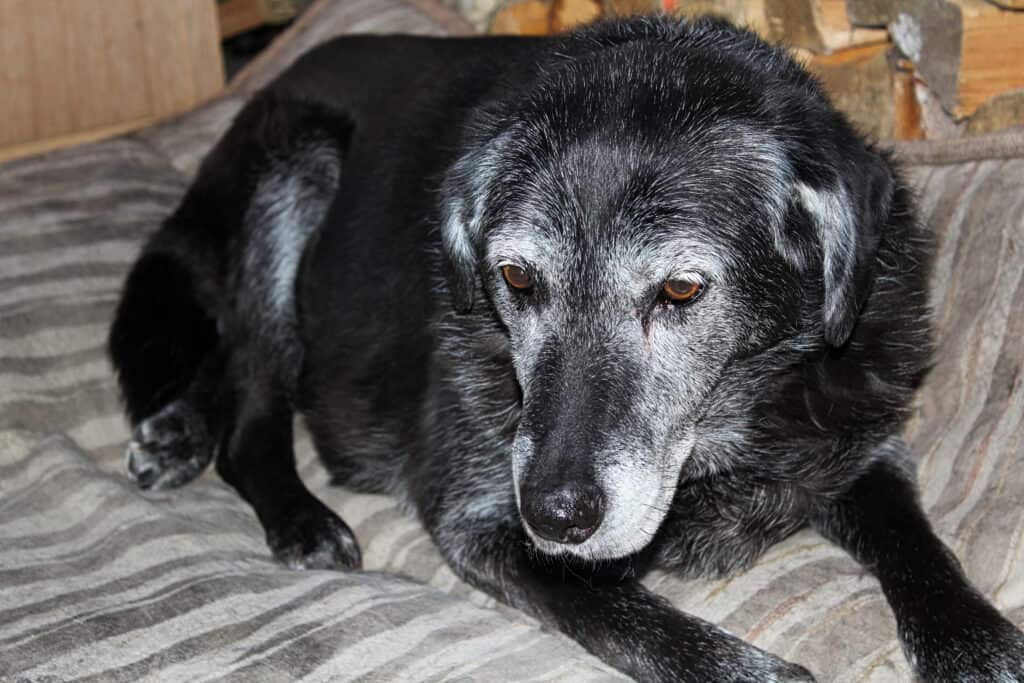Do you ever get the feeling that you are being watched? If you are a dog owner then you are probably right because dogs stare at their owners quite a lot! Perhaps you have caught them at it and wondered why does my dog stare at me? You are not alone!
This is a very common experience for dog owners and there are many possible explanations. It can be connected with what you are doing at the time or with what your dog is feeling. Dogs stare to communicate a desire for a treat, to go outside, to play or sometimes, it’s simply because they love you! When dogs stare at you – they may also be trying to understand your feelings. If you’d like to be able to interpret what this behavior means, then we have all the information you need right here.
It Helps Them Read Us
Dogs and humans have lived together for hundreds of years. We get on so well because we take the time to work each other out. You are reading this right now because you want to understand your dog better. Your dog stares at you because they are trying to figure you out. We have purposely bred dogs that are interested in humans and that are good at interpreting what we want. For centuries, working dogs have needed to watch their owners intensely waiting for their next instruction.
Even if your pooch is not a working dog, they have a lot to gain from being able to interpret your actions. Your dog is watching your movement, body language and facial expressions. They are waiting for a sign that we are going to do something that impacts them. If we get up from the sofa it may mean that we are going to feed them. If we go to the fridge, it may mean that we are going to sneak them a bit of cheese. And if we pick up a leash…oh boy it means we are going for a walk!

Dogs sometimes stare at us because they know our actions affect them – like if we go to pick up the leash, that means they’re going on a walk!
©Reddogs/Shutterstock.com
It’s Caused by Our Training
Most of us use positive training methods to get our dogs to do what we tell them. We start with simple commands such as ‘sit’ and move on to more complex maneuvers with some dogs. Your dog soon learns that you are the source of good things like toys and treats. The last thing they want is to miss an opportunity to be a good boy or good girl and get a treat for obeying a command. So, they watch you intently waiting for an opportunity to get a reward.
They Are Telling Us Something
Communication goes both ways. So, as well as trying to pick up information from us our dogs may be trying to tell us something. Most of the time this is because they want something from us. Physical needs are the obvious place to start. Your dog may be thirsty, hungry or need to go potty. Dogs that know that they are not allowed to jump up and whine at the dinner table, often sit and stare at you instead, following every forkful into your mouth!
Dogs also have emotional needs so they may want you to pet them or play with them. If you have started rewarding them with what they want when they stare at you, they will continue to do it.

Sometimes dogs stare at us because they’re hungry.
©Gladskikh Tatiana/Shutterstock.com
They Can’t Work Us Out
Have you noticed that your pooch stares at you most when you are doing something goofy like dancing around the kitchen to the radio? Remember that you are a different species and so your dog can find it hard to work you out. Staring can mean that they are very confused by what you are doing and are trying to gather information to help them work it out.
Expressing Emotion
Eye contact is a type of body language used by dogs. It can express both positive and negative emotions. Let’s look at the positive first. Staring between dogs and humans releases the feel-good hormone called oxytocin in both of them. It is an expression of love and your dog may simply be indicating how much they adore you.
Staring can also be an expression of aggression in dogs. In wild dogs, like wolves, staring is an expression of rudeness and aggression. It is a threatening body stance. If a dog that you do not know stares at you and has a stiff posture, don’t stare back at them. Instead, move calmly away without making eye contact. Even your own loving pet may stare at you if they have a valued item that they think you are going to take away from them! They may growl at the same time. This is called resource guarding.

Wild dogs such as wolfs often stare as a way to assert dominance or be aggressive.
©Paul Aparicio/Shutterstock.com
When Staring Is a Bad Thing
We’ve already outlined that in some cases a dog staring can be a sign of aggression or guarding. It can also be a little manipulative if they learn that it makes you feel uncomfortable and it gets them what they want!
Staring can also indicate that there is something wrong with your dog. If you have a senior dog, staring into space can mean that they are developing dementia and you need to consult your vet. This is a type of cognitive decline that can also result in memory loss, changes in feeding and sleeping patterns and pooping and peeing in the house. As your dog grows older, you can help to support them by feeding them a diet designed specifically for senior dogs.

Staring into space can be a sign of dementia in older dogs.
©Amelia Martin/Shutterstock.com
Your dog may also be staring at you because they need your help. Perhaps they are sick or in pain? There will usually be some other signs indicating that all is not well with your four-legged friend. They may be subdued, off their food or have vomiting or diarrhea. Your vet will be able to find out what is wrong.
When Staring Is a Good Thing
Whilst being stared at may make you feel a bit uncomfortable, it is essential from a dog-training point of view. The principle that underpins all successful dog training techniques is engagement. If your dog is not engaged with you, they are not interested in what you are doing and you may as well not exist. They will not come back to you when you call them or obey any commands that you give.
Highly trained dogs are always waiting for the next command so that they can respond instantly. Their focus is on you and not on whatever else is going on around them. For this reason, an attentive dog is a good thing! They tend to excel at sports that require immediate obedience such as agility competitions and AVC rallies. These dogs also make the best working dogs whether that’s herding livestock on a farm or working as a rescue dog up a mountain.

Highly-trained dogs stare because they’re awaiting their next orders.
©lightman_pic/Shutterstock.com
If you would like to encourage engagement and get your dog to look at you more often, there are a few things that you can do. You could teach them the ‘watch’ or ‘look at me’ command by rewarding them with a tasty treat when they focus on you. This can be very useful when you are in a highly distracting environment and you need your dog to listen to you.
Hand feeding your dog also increases engagement. Instead of putting their food in a bowl. Get a canister and hand feed them as you are walking them. This works best with dry kibble but can also be done with wet food if you don’t mind getting a bit messy!
How to Stop Excessive Staring
If your dog is staring at you in an aggressive way, it is time to use the services of an experienced dog trainer or dog behavior expert. You must do this quickly before they become a danger to humans or other dogs.
Staring associated with guarding is also tricky to tackle. For owners of several dogs, the easiest approach is not to expect them to share! When you get a chew toy for one of them, get a toy for all the other dogs too.
Compared to other ways that dogs try to get your attention (barking, whining, weaving around your legs) staring at you is not that annoying! But if you would like to discourage it, you need to provide an alternative for your dog to do.
So, you could teach your dog to go to their bed or crate when you are eating a meal to avoid them staring at every mouthful. You could also keep them busy whilst you are eating by getting an interactive toy.
For dogs that want to play – ALL THE TIME – you need a game that requires maximum effort from them and minimum effort from you. An automatic ball launcher is the perfect answer!
Some owners even use bells that dogs can ring to indicate that they need to go outside for a potty break!
- Available in 4 colors
- Non-skid rubber bottom protects your floor from scratches
- Easy to use -- just place them on a flat surface
- Constructed from metal with printed pawprints
- Portable
The photo featured at the top of this post is © Sofia Abellan/Shutterstock.com
Ready to discover the top 10 cutest dog breeds in the entire world?
How about the fastest dogs, the largest dogs and those that are -- quite frankly -- just the kindest dogs on the planet? Each day, AZ Animals sends out lists just like this to our thousands of email subscribers. And the best part? It's FREE. Join today by entering your email below.
Thank you for reading! Have some feedback for us? Contact the AZ Animals editorial team.







